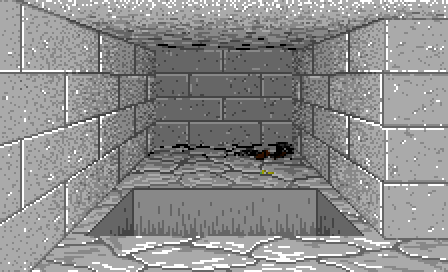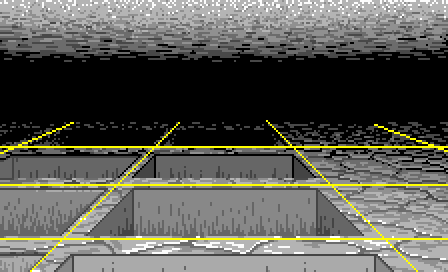Downloads
Executable for the map editor - exactly the same as in part 35 (Windows 32bits)
Executable for the game (Windows 32bits)
Before you try to compile the code go to the "Projects" tab on the left menu, select the "Run" settings for your kit,
and set the "Working directory" to the path of "editor\data" for the editor or "game\data" for the game.
Parameters

Pits are very simples. They will use these parameters:
<tile name="Pit">
<image>Pit.png</image>
<param type="int">Level</param>
<param type="int">X</param>
<param type="int">Y</param>
<param type="bool">isClosed</param>
</tile>
And isClosed tells if it is opened or closed.
Graphics
The right ones are simply the left images flipped.

The drawing function is very simple too. Quite similar to the ornates, except that the graphics and their
coordinates are hardcoded in a table.
struct SPitData
{
char file[32];
int16_t x, y;
};
static const SPitData gPits[WALL_TABLE_HEIGHT][(WALL_TABLE_WIDTH + 1) / 2] =
{
{{"Pit03.png", 0, 96}, {"Pit13.png", 6, 98}, {"Pit23.png", 80, 98}}, // Row 3
{{"", 0, 0}, {"Pit12.png", -1, 109}, {"Pit22.png", 66, 110}}, // Row 2
{{"", 0, 0}, {"Pit11.png", -3, 127}, {"Pit21.png", 43, 127}}, // Row 1
{{"", 0, 0}, {"Pit10.png", 0, 159}, {"Pit20.png", 27, 160}} // Row 0
};
void CTiles::drawPit(QImage* image, CVec2 tablePos)
{
const SPitData* data;
// get the table data
bool flip = (tablePos.x >= (WALL_TABLE_WIDTH + 1) / 2);
if (flip == false)
data = &gPits[tablePos.y][tablePos.x];
else
data = &gPits[tablePos.y][WALL_TABLE_WIDTH - tablePos.x - 1];
// display
if (data->file[0] != 0)
{
std::string fileName = std::string("gfx/3DView/pits/") + std::string(data->file);
QImage pitImage = fileCache.getImage(fileName);
CVec2 pos = CVec2(data->x, data->y);
if (flip == true)
pos.x = MAINVIEW_WIDTH - pos.x - pitImage.width();
QRect clip(0, 33, MAINVIEW_WIDTH, MAINVIEW_WIDTH);
graph2D.drawImage(image, pos, pitImage, 0, flip, clip);
}
}
that were not used in the game.
There are graphics for the pits in the ceilings that you can see from the level below after falling, but I did not
have time to include them in this part.
Falling
the mainLoop() function:
if (destTile->getType() == eTilePit && destTile->getBoolParam("isClosed") == false)
{
sound->play(pos, "sound/Scream.wav");
shouldFall = true;
interface.setMainState(CInterface::eMainFall);
}
if (player.shouldFall && sound->isFinished(player.pos, "sound/Scream.wav") == true)
player.fall();
void CPlayer::fall()
{
CTile* tile = map.getTile(pos);
int level = tile->getIntParam("Level");
CVec2 newPos = CVec2(tile->getIntParam("X"), tile->getIntParam("Y"));
game.loadLevel(level, newPos, dir);
shouldFall = false;
interface.setMainState(CInterface::eMainGame);
}
Dropping objects in pits
When we drop an objet on one of theses tiles, we call a function that moves all the objects stacks on this tile:
void CGame::fallStacks(CVec2 mapPos)
{
CTile* tile = map.getTile(mapPos);
std::vector<CObjectStack> copyStacks;
// copies the stacks
for (int y = 0; y < 2; ++y)
for (int x = 0; x < 2; ++x)
{
CVec2 objPos = mapPos * 2 + CVec2(x, y);
CObjectStack* stack = map.findObjectsStack(objPos, eWallSideMax);
if (stack != NULL)
{
CObjectStack copy = *stack;
copy.mPos = CVec2(x, y);
copyStacks.push_back(copy);
map.removeObjectsStack(objPos, eWallSideMax);
}
}
int lastLevel = currentLevel;
CVec2 lastPos = player.pos;
uint8_t lastDir = player.dir;
int level = tile->getIntParam("Level");
CVec2 newPos = CVec2(tile->getIntParam("X"), tile->getIntParam("Y"));
// load destination level
loadLevel(level, CVec2(), 0);
// set the stacks at the new pos
for (size_t i = 0; i < copyStacks.size(); ++i)
{
CVec2 objPos = newPos * 2 + copyStacks[i].mPos;
CObjectStack* stack = map.addObjectsStack(objPos, eWallSideMax);
for (size_t j = 0; j < copyStacks[i].getSize(); ++j)
stack->addObject(copyStacks[i].getObject(j));
}
// reload the last level
loadLevel(lastLevel, lastPos, lastDir);
}
Level 3 and scripts
You can find it in the "data/maps" folders of the sources.
There are only a few tiles and teleporters to bring you back to level 2.
But at least the game does not crash anymore when you take the stairs at the end of level 2.
I also wrote a few scripts to open/close the pits according to the puzzles.
They are as simples as the ones to open/close the doors because we only have to change a boolean value.